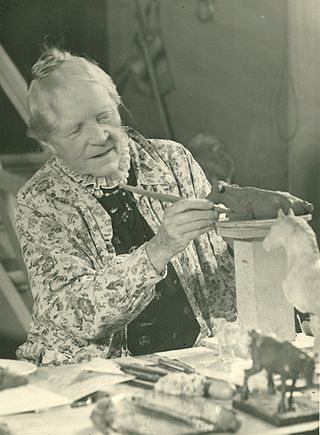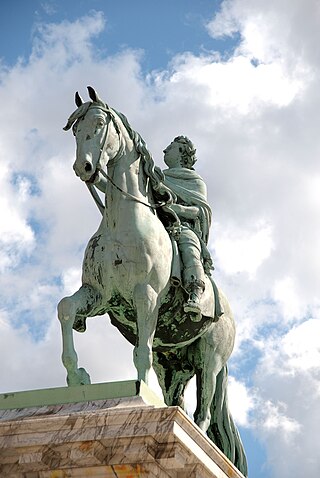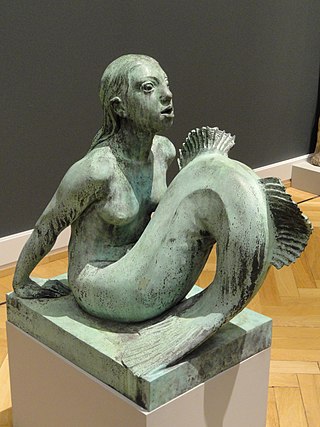
Frederik IX was King of Denmark from 1947 to 1972.

Princess Benedikte of Denmark, Princess of Sayn-Wittgenstein-Berleburg is a member of the Danish royal family. She is the second daughter and child of King Frederik IX and Queen Ingrid of Denmark. She is the younger sister of Queen Margrethe II of Denmark, and therefore the aunt of Margrethe's son, the current King of Denmark, Frederik X. She is also an older sister of Queen Anne-Marie of Greece.

Amalienborg is the official residence for the Danish royal family and is located in Copenhagen. Frederick VIII's palace complex has four identical Classical façades, effectively four palaces, with Rococo interiors, laid around an octagonal courtyard. At the centre is a large equestrian statue of Frederick V. Amalienborg was originally built for four noble families, but after Christiansborg Palace burned in 1794 the royal family bought the palaces and moved in. Over the years various monarchs and their families have lived there, including today's King Frederik X and Queen Mary.

Christiansborg Palace is a palace and government building on the islet of Slotsholmen in central Copenhagen, Denmark. It is the seat of the Danish Parliament, the Danish Prime Minister's Office, and the Supreme Court of Denmark. Also, several parts of the palace are used by the Danish monarch, including the Royal Reception Rooms, the Palace Chapel and the Royal Stables.
Events from the year 1927 in art.

Christian Gottlieb Vilhelm Bissen was a Danish sculptor. He was also a professor at the Royal Danish Academy of Fine Arts with great influence on the next generation of Danish sculptors and for a while served as its director. Bissen was trained in the Neoclassical tradition from Bertel Thorvaldsen but after a stay in Paris around 1880, he was influenced by Naturalism. With the equestrian statue of Absalon he turned to Neo-romanticism.

Anne Marie Carl-Nielsen was a Danish sculptor. Her preferred themes were domestic animals and people, with an intense, naturalistic portrayal of movements and sentiments. She also depicted themes from Nordic mythology. She was "one of the first women to be taken seriously as a sculptor," a trend-setter in Danish art for most of her life. She was married to the Danish composer Carl Nielsen.
Events from the year 1863 in Denmark.
Events from the year 1873 in Denmark.

Danish sculpture as a nationally recognized art form can be traced back to 1752 when Jacques Saly was commissioned to execute a statue of King Frederick V of Denmark on horseback. While Bertel Thorvaldsen was undoubtedly the country's most prominent contributor, many other players have produced fine work, especially in the areas of Neoclassicism, Realism, and in Historicism, the latter resulting from growing consciousness of a national identity. More recently, Danish sculpture has been inspired by European trends, especially those from Paris, including Surrealism and Modernism.

Civiletatens Materialgård is a former storage facility at Frederiksholm Canal in Copenhagen, Denmark. The complex was used for the storing of materials used for the royal palaces but also has a long history as home and work place for sculptors associated with the Royal Danish Academy of Fine Arts. Together with the adjacent Fæstningens Materialgård, its military counterpart, and the Royal Horse Guards Barracks, it forms a cluster of low, yellow-washed buildings alongside Frederiksholm Canal. It now houses the Art Academy's School of Sculptury as well as residences.

Jørgen Gudmundsen-Holmgreen was a Danish sculptor.

The Equestrian statue of Frederick VII in front of Christiansborg on Slotsholmen in Copenhagen, Denmark, was modelled by Herman Wilhelm Bissen and completed posthumously by his son Vilhelm Bissen in 1873. It was created to commemorate King Frederick's central role in Denmark's transition from absolute to constitutional monarchy.

Mermaid is a bronze sculpture designed by the Danish sculptor Anne Marie Carl-Nielsen, depicting a mermaid. The original bronze cast from 1921 is on display in the Danish National Gallery while another cast was installed at Christians Brygge outside the Royal Danish Library in Copenhagen in 2009. The original plaster model is owned by the Carl Nielsen Museum and is on display in the Funen Art Museum in Odense. Carl-Nielsen depicts her mermaid in a more dramatic pose than that of Edvard Eriksen's far more famous and nine years older Little Mermaid at Copenhagen's Langelinie promenade.

Christians Brygge is a waterfront and street in central Copenhagen, Denmark. It runs from the mouth of Slotsholmen Canal in the north to Langebro Bridge in the south where it turns into Kalvebod Brygge. Its northern end, which is located on the small isle of Slotsholmen, is connected to Niels Juels Gade and then Holmens Kanal by Christian IV's Bridge. Christians Brygge The road section is part of Ring 2. The name refers to Christian IV, king of Denmark during the first half of the 17th century, who constructed several buildings at the site, including the Arsenal and Christian IV's Brewhouse as well as nearby Børsen. Other landmarks along the quay include the Royal Danish Library and the mixed-use building BLOX, home to the Danish Architecture Centre.

Helen Schou was a Danish sculptor most known for her works of horses. Her two most-known commissions are the equestrian statue of King Christian IX commissioned for the Aarhus Cathedral and the Jutland Stallion commissioned by the City of Randers. She was honored as a Knight of the Order of the Dannebrog in 1965 and elevated to a Knight 1st Class in 1974.

The equestrian statue of Christian V, located in the centre of Kongens Nytorv, is the oldest of five equestrian statues of Danish monarchs in Copenhagen, Denmark. The equestrian statue was created by the French sculptor Abraham-César Lamoureux, inspired by French equestrian statues that had themselves been based on the Equestrian Statue of Marcus Aurelius. Dating from 1688, it was originally made in gilded lead but recast in bronze in 1939.

The Carl Nielsen Monument, located at the corner of Grønningen and Store Kongensgade in central Copenhagen, Denmark, is a monument to Danish composer Carl Nielsen created by his wife Anne Marie Carl-Nielsen. It depicts a young man playing pan-pipes on a wingless Pegasus and is also known as The Genius of Music. The original plaster model is owned by the Carl Nielsen Museum in Odense.
















